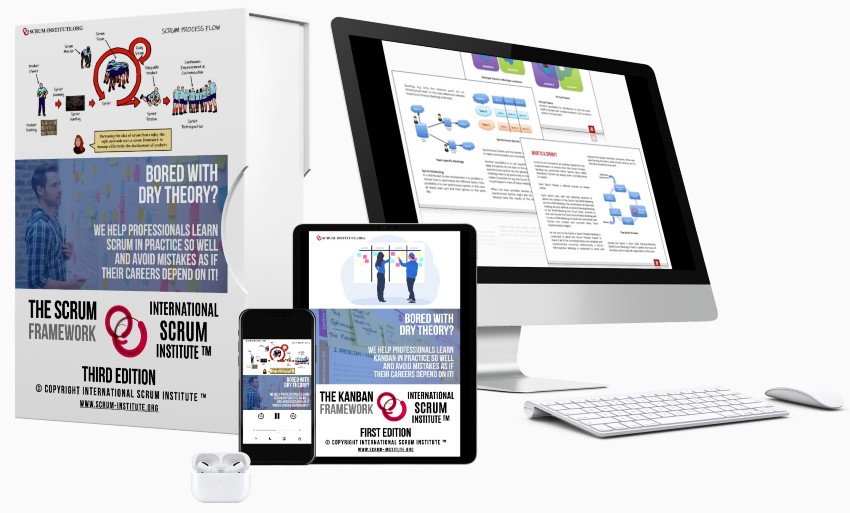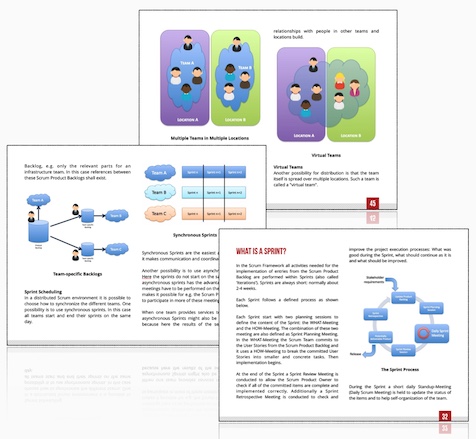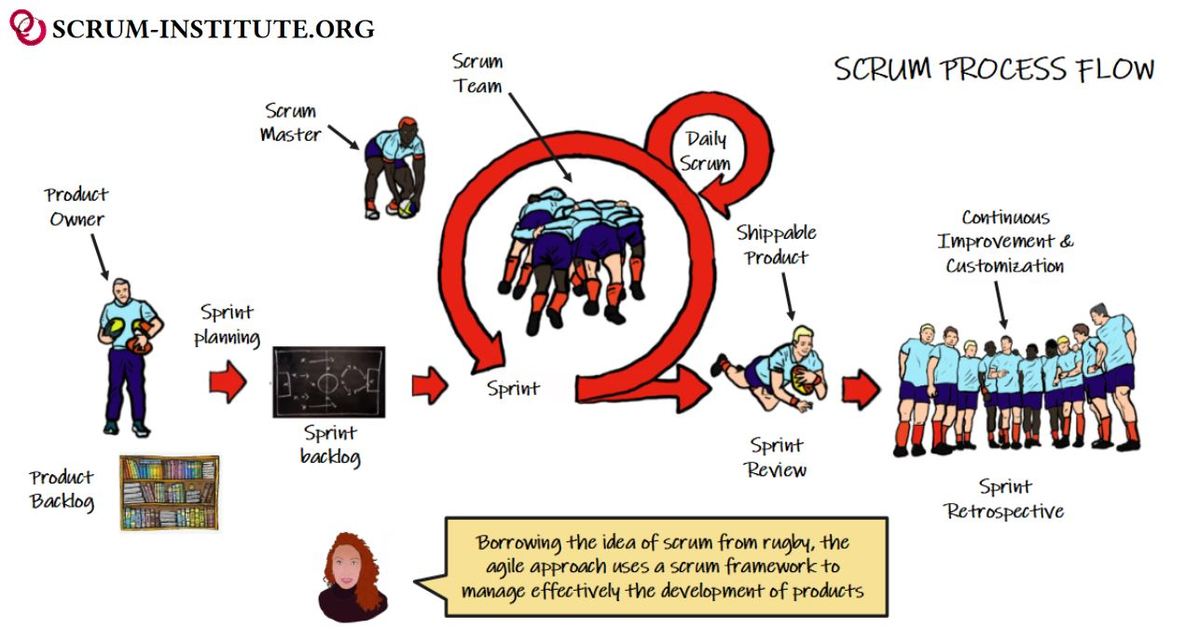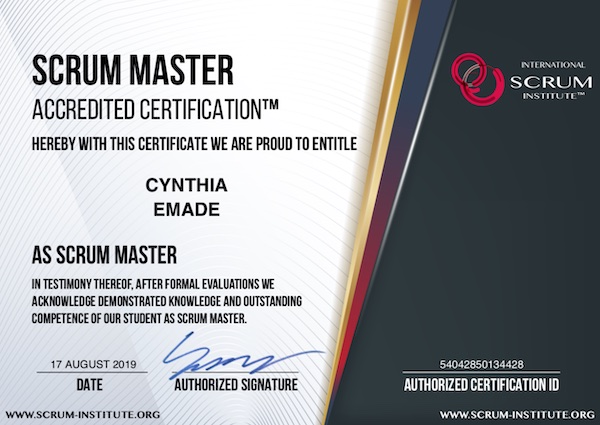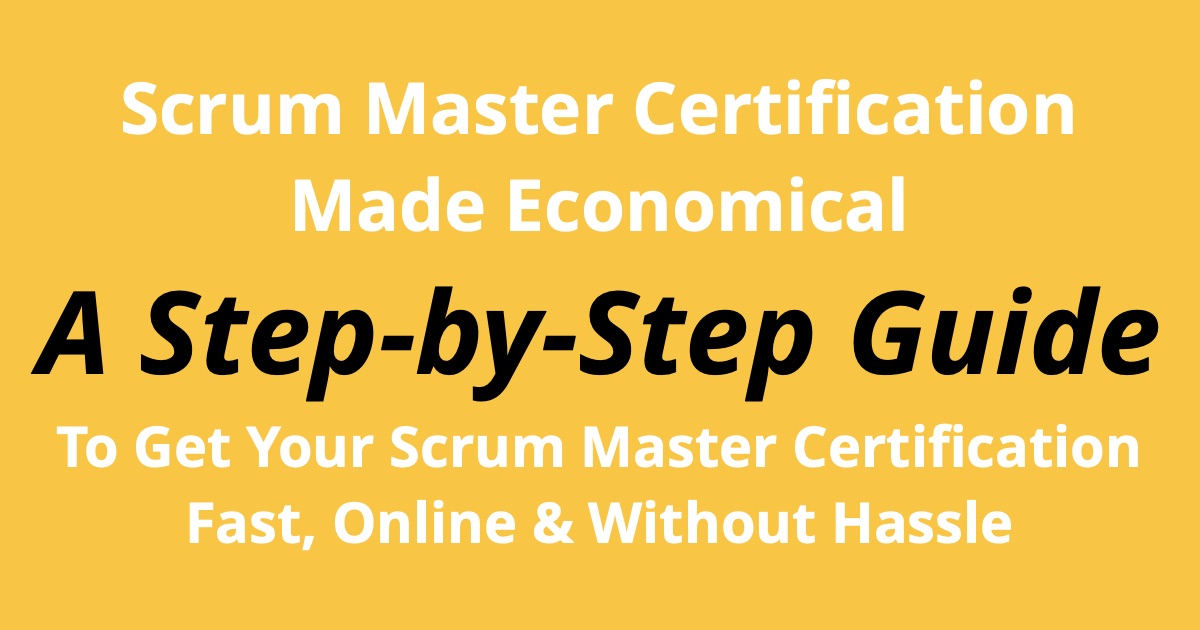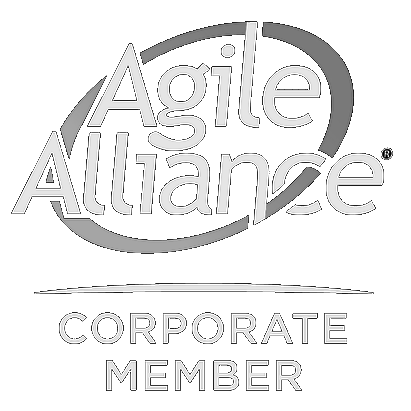Scrum Master Certification Made Economical: Step-by-Step Plan
We are proud to announce that this article was featured...
HERE on LinkedIn >>>
Ever since the scrum framework became one of the best ways to develop and deliver software, everyone seems to have the same goal.
To wake up in the morning, open their laptop, have the exciting peace of mind of possessing something like this:
Scrum master certification.
That’s the dream, right?
Deliver great software to your employers and clients.
Have the fantastic career fueled by your skills and know-how in the scrum process and your scrum master certification.
For most of the people, scrum master certification is how they get started with the scrum framework.
In this article for the first time, I would like to share an advanced and detailed step-by-step guide for you to help you get your scrum master certification.
Economically, fast, online and without hassle!
In only four easy steps, you can become an outstanding scrum professional with your scrum master certification.
My goal with this article is to show you ways how Scrum can improve yourself in your career and your professional ability in your work. Also, why you should be continuously obtaining skills and aptitudes of a scrum master sooner rather than later.
Definition - What is the Scrum Master Certification?
You can find the best definition of what scrum master certification is on International Scrum Institute™’s Scrum Master Accredited Certification™.
Scrum master certification is the testimony of your competence in the Scrum software development and delivery process. Scrum master certification acknowledges your demonstrated knowledge and outstanding expertise in the Scrum framework after a formal multiple-choice test evaluation.
Scrum software development process has been offering immense benefits to millions of professionals until today. Therefore, there is no reason that you won’t join these accomplished men and women who upgraded their careers and skills with the help of the scrum framework.
If you still wonder, I want to assure you that you can no longer imagine a growing career without possessing a scrum master certification. It’s regardless of your role, title, and experience in Information Technology (IT) ecosystem.
You even don't have to be an IT professional anymore to understand what scrum is, how scrum works, and get a scrum master certification.
Whatever you do for a living, regardless you're part of an IT department or not, there is an essential and indisputable fact. Your tasks and professional business value you've been serving for your organization are dependent on and interrelated to IT, software, and agile scrum process and principles.
Moreover, thanks to the shift of traditional business models into software as a service (SaaS) driven businesses or so-called digitalization movement, it's no longer a voluntary decision for any professional in or outside the IT department to get certified as a scrum master. However, it's a must today to get a scrum master certification.
You may be just starting your career, or you may be a seasoned IT professional. It doesn't play a role. You need to get your scrum master certification.
Your role may or may not include people and functional management activities. It doesn't matter too; you still need to have a scrum master certification.
You may have a title like:
- business analyst,
- software architect,
- enterprise architect,
- software designer
- user experience (UX) designer,
- user interface (UI) designer,
- software developer,
- software development manager,
- test engineer,
- test automation specialist,
- test manager,
- IT systems operations specialist,
- Unix/Linux administrator,
- information security (InfoSec) engineer,
- IT network engineer,
- database administrator (DBA),
- project manager,
- program manager,
- product manager,
- team leader, manager, director or executive,
- alternatively, any other title that I didn't list here.
You should learn scrum software development framework and become a scrum master today by getting your scrum master certification.
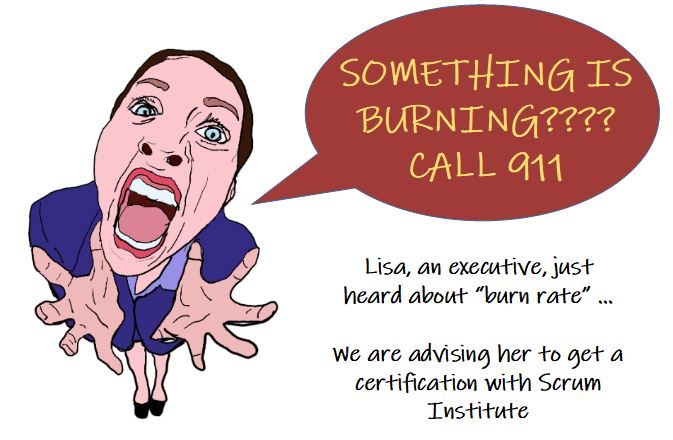
3 Elements of Chaos and Frustration Before Agile Scrum Process and Scrum Master Certifications
To better understand the impact of the scrum framework to our software engineering practices and businesses, it makes sense to have a look at a day in the life (or a software project in life).
Therefore, I would love to briefly talk about a software project from the past before we adopted the scrum development and software delivery framework in our organizations.
A few days before I wrote these lines, I had lunch with one of my ex-colleagues with whom we used to work together almost 20 years ago. This gentleman, Marcus has got his scrum master certification and scrum product owner certification from International Scrum Institute™.
He currently works as a scrum master for one of the leading software houses in the agile project management software domain.
As a scrum master, Marcus is now in charge of operating an agile scrum team whose scrum team members located in geographically distributed locations around the globe.
During our lunch, Marcus admitted that there are a lot of typical challenges with distributed agile scrum teams. Some of the problems he specifically mentioned related to his software project configuration are:
- Differences in working styles among scrum team members,
- Timezone differences,
- Cultural misfits, and
- Language constraints.
Despite these difficulties, Marcus still added that running a software project with the agile scrum process is more fun, productive, and enriching than how we used to work 20 years ago. Compared to days when we used to work without scrum software development and scrum software delivery processes.
Marcus’ statement was indeed a big testimonial for the credit of the scrum framework from a very accomplished and experienced manager, scrum master, and product owner.
Thank you, Marcus!
Then I explained to him one of my past software projects before I used to meet with the scrum framework. I'm sure that many scrum masters would resemble this experience to their previous projects before they've gotten their scrum master certifications.
Back in the late 1990s, I was part of a software engineering group to build a smart card-based public key infrastructure. Smart cards securely protected private keys of infrastructure members, associated public keys and their wrapper certifications were openly distributed (as the name public implies).
Back in the day, this was by itself a relatively complex IT project that required multiple interdependent hardware engineering and software engineering teams. We had to do massive amounts of research and development (R&D) to build a fully functional hardware and software system.
Remember these are days before we had the minimum viable product (MVP) concept to experiment, create, learn, and experiment again.
If you're interested to learn more about how to build an MVP in Agile methodology, feel free to check out this article from Cleevio which will give you a better overview of this complex process.
Without scrum to create such a sophisticated infrastructure that constituted numerous hardware and software elements was a real challenge.
Here are three significant setbacks we used to have without any scrum masters and anyone who possesses a scrum master certification in our teams.
The 1st Element of Chaos and Frustration Without Scrum Master Certification: We Had to Plan Our Entire Project Before We Understood What The Project Was All About
Without scrum, our teams had built and delivered entirely wrong software and hardware products that did not fulfill demands from our client.
We had times in our professional lives when some third party companies had imposed how we supposed to build our software products or software services.
Capability Maturity Model (CMM), ISO 9001:2008 and other derivates attempted to help our companies to ensure we build our correct software in correct ways.
How successful they used to be is not part of this article. This article was meant to focus on the scrum process and merits of a scrum master certification rather than criticizing almost extinct procedures.
However, I have to add that these process improvement frameworks before the scrum software engineering framework recommended a phased approach. They advised a phased software engineering approach which we called the waterfall software engineering model.
With the waterfall model, each software project was supposed to start with requirement analysis, where we aimed to understand what our client needed and wanted.
Then we designed these requirements, we implemented them, we tested (verified) them, and we maintained them in our software production environments. Finally, we reached to end of the software engineering lifecycle.
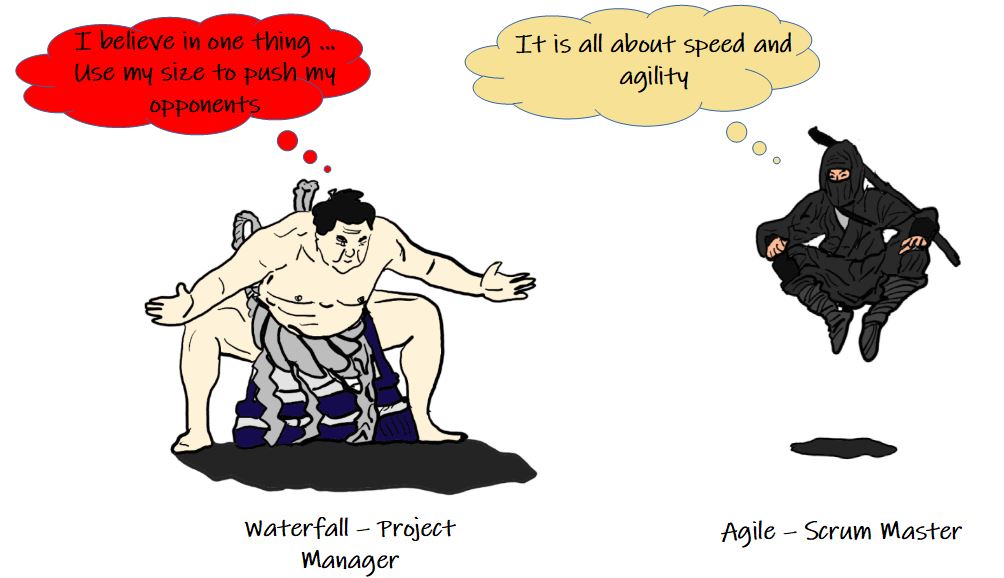
Nonetheless, the reality didn't play out like that!
The adverse effects of unforeseen delays happened during a particular phase of the waterfall software engineering model were inevitable to the following software engineering phases.
It was life before the Scrum framework.
Sending our software back and forth between various teams, without the guidance of professionals with scrum master certifications, made our work bureaucratic, complex and unproductive.
Finally, it wasn't only the product which suffered, but also employee morale and commitment to our organizational mission have wholly disrupted.
The 2nd Element of Chaos and Frustration Without Scrum Master Certification: Lack of Commitment, Change Management, and Working Together Disciples Among Different Teams
The most significant weakness of process improvement frameworks used before Scrum was that: They mainly focused on self-serving organizational demands of leadership.
Some of these demands are monitoring, compliance, and predictability. There was no focus on serving clients well and increasing employee morale at all.
Thus members of software management teams and various other internal and external stakeholders attempted to have a fixed deadline for software delivery projects and easily monitor the progress of software engineering phases.
They penalized their people if something was outside the planned track, and they hoped to fix emerging issues before the scheduled date of project completion.
Furthermore, independent silos realized entirely separated software engineering phases. As an example, the development team was completely independent of a software testing (verification) team. Most people who supposed to work for the same business mission didn't even know each other by their names.
Have you got a guess about the reason for this silo-mentality in our organizations rather than focus on business missions and professional (business) maturity of employees?
The reason is simply the matrix management. Matrix management is an organizational management and employee structure, and it has been in our businesses since the 1970s. At first glance, the differentiating idea behind a matrix organization or matrix management seems to be smart.
The Leadership creates an organizational structure by bringing together employees with similar kinds of functional and technical skillsets into the same or at best neighbor silos.
Back in times, it was quite popular to see the so-called "Center of Competences" in our companies where each center of competence represented an independent and autonomous silo.
One silo for C++ developers, another silo for database administrators, and another entirely separate quality assurance silo in oversees and it goes on and on. Go and figure!
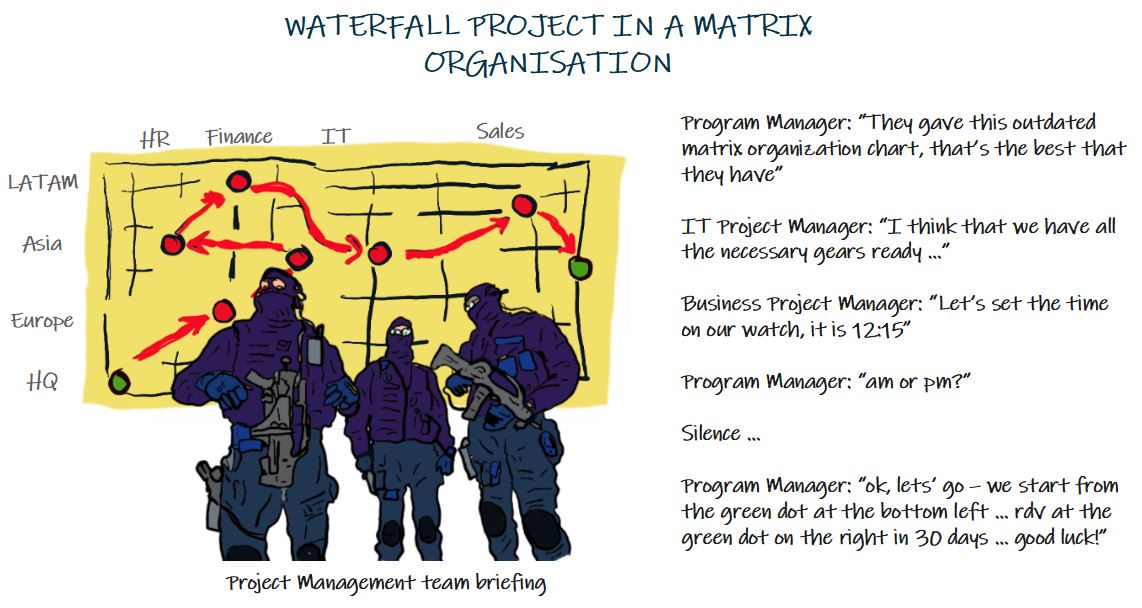
The biggest challenge with the matrix organizational structure was that: To deliver a software project without the scrum framework and scrum masters, project managers had to borrow employees from silos temporarily.
These employees did not even physically position with their project teams, but they still located in the rooms of their particular center of competences.
Up upon completion of projects, these temporary project teams dissolved and project participants moved on their next assignments to serve for other projects.
Therefore, the targeted business values of these ongoing software projects have never been the utmost priority for these independent silos.
They tend to see their work as checkboxes they ticked for one project over here and another project over there.
Leadership and matrix organizational model didn't teach them how professionals should commit their business to improve the bottom line, including sales, revenue, and profit.
A McKinsey Quarterly article written by McKinsey & Company has also clearly illustrated this illusion of cost optimization beyond the matrix organization.
Gartner has estimated that organizations worldwide have been yearly spending 600 billion USD to recover their IT systems from non-scheduled maintenance work and defects.
Now let's take a short moment to visualize how the change management and impediment handling of software projects played out. How they played out in a project configuration with the waterfall model, with the matrix organization, and without the scrum process.
Yes. You're right. Management and employees treated change management, impediment, and error handling as if they're ill exceptions which shouldn't have happened in the first place.
Therefore, changes in a software project have been the synonym of delays. They usually created a domino effect of cascading delays. Teams required someone to blame and finger-point for defects and impediments.
Last, but not least, because silos did not have a mechanism in place to process, fix, and learn from their errors, they kept on repeating the same mistakes.
Furthermore, they kept on augmenting the amount of technical debt while they passively attempted to deal with their problems.
The 3rd Element of Chaos and Frustration Without Scrum Master Certification: Autocratic Decisions Overruled Democratic Decisions
Steve Jobs once said:
"It doesn't make sense to hire smart people and tell them what to do. We hire smart people, so they can tell us what to do."
However, this is precisely opposite of how most of the mainstream leadership used to operate to make decisions before the scrum era.
Before we had the scrum process in our organizations, autocratic decisions from leaders overruled the combined intelligence of their teams.
They invalidated the democratic decision-making ability of groups who were in charge of doing the real works which spanned the entire software engineering lifecycle from the conception of software to its operations.
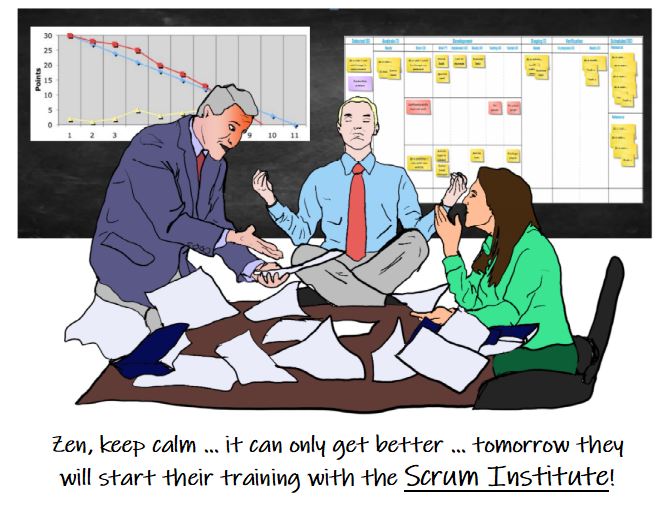
The remoter a decision was shifted away from work centers (teams) it impacted, the more difficult it was to give a correct mission-critical decision.
The judgments from leaders used to be usually impulsive, not thoroughly thought-out, mostly late and tentative, but sometimes even too early.
These autocratic decisions imposed from the top made employees feel undervalued. They entirely hindered the ability of their organizations to come up with creative and innovative solutions to handle competitive business and software-related challenges.
Furthermore, they discouraged software engineering teams from giving their inputs at the times when they're asked to contribute decisions.
It was a brief overview of how we used to develop and deliver our software services and service products before we adopted the scrum framework in our organizations. Now let's have a look at how we sorted out these chaos and frustration elements with the help of the scrum process.
What is Scrum?
First of all, I would like to emphasize that I didn't intend to write this section of the article as a go-to reference to answer all questions about the scrum framework. Nonetheless, the substance we're discussing here will give an in-depth headstart for most of the beginner and intermediate level scrum professionals.
However, for the ones who are looking for a more advanced, but still practical guide to learn scrum framework quickly, we have got something as well. I suggest you go and download our guide for the scrum framework from the link here.
What is Scrum? Well, without making things too complicated, the scrum framework can be defined as the following:
Scrum is an iterative software engineering process to develop and deliver software.
Although the software is the main focus of the scrum framework, iterative and agile scrum process can be and is already being applied outside the software industry as well.
Most people in the IT industry believe that the term "Scrum" was coined early in the 2000s as a parallel track of emerging agile software development and delivery trends. That's is a piece of incorrect information!
The term "Scrum" was first used and published by Harvard Business Review in January 1986. Hirotaka Takeuchi and Ikujiro Nonaka coined the term "Scrum" with their article: The New New Product Development Game. (Yes, two News)
You should have a look at "The New New Product Development Game" to see how everything all about Scrum got started!
When the IT industry talks about the scrum framework, It's also often we hear the term "Agile Scrum" along the same lines as "Scrum". It led some of us in the industry to think and look for differences between the terms "Agile Scrum" and "Scrum".
Here is good news for you. "Agile Scrum" and "Scrum" terms do both refer to the same thing. They both refer to the scrum software engineering process. Then why do we sometimes use the word "Agile" in front "Scrum"?
It's because the scrum framework fully embraced and embedded Agile Manifesto (Manifesto for Agile Software Development) to its core process, principles, and underlying philosophy. That brings us to understand the agile manifesto and the values of the scrum process better before we deep-dive the technicalities of the scrum process.
The Agile Manifesto (Manifesto for Agile Software Development)
Agile manifesto values:
- Individuals and interactions over processes and tools,
- Working software over comprehensive documentation,
- Customer collaboration over contract negotiation,
- Responding to change over following a plan.
While the factors on the right-hand side do still possess significant values, the agile manifesto appreciates and prioritizes the factors on the left-hand side higher.
The elements favored by the agile manifesto have been carefully time-tested and chosen to:
- Serve clients and stakeholders better and create value for them with software,
- Enhance the profession of software engineering regardless of your role, title, and career level.
Values of the Scrum Framework
I have already mentioned that the scrum framework is not only a software engineering process. It also has a robust set of underlying principles.
In fact, most of the professional business domains can apply and utilize these principles.
It’s not enough to get a scrum master certification to be hugely successful with the scrum. You should possess a firm grasp for scrum values to succeed with the scrum.
So that you’re going to deliver a great job and fantastic software that your customers and employers love. Let me now tell you more about those principles of the scrum process.
Courage
There are times when doing the correct thing to serve the best values and benefits for our clients are not the easiest. In such moments, scrum master, scrum product owner, and the scrum team members should remember their duty and obligation.
That's to build the best possible products and services in their particular business and information technology domain. To be better than mediocre, a scrum team should sooner or later face difficult decisions that won't make everyone happy in their particular ecosystem of stakeholders.
To deal with this, all members of the scrum team should remember what they learned during their scrum master certification training.
They should remember to be courageous, and they should master to decide and act courageously.
Focus
With the scrum framework, when you hear the value focus, you should be thinking about two things:
- Identification of correct work: What tasks are necessary to deliver the goals of my sprint? What are essential to developing the best software products and services for my clients so that they will be pleased with my work?
- Prioritization: What tasks should I be working on next?
Each moment in time, there is one critical question that the entire scrum team, including scrum master and product owner, must be answering. This question is: "What are the most important things we should be doing at the moment to fulfill reasons of why an employer hired us in the first place?"
Scrum framework has several built-in events (rituals) to ensure the reasonable prioritization of user stories and tasks. According to the scrum process, the prioritization of user stories and their associated tasks should have a continuous priority.
So we make sure that the scrum team works on the right things in the correct order. Some of the built-in scrum ceremonies (scrum events) to prioritize our work and adjust our focus are:
- Scrum Grooming Meeting: Grooming meeting solely focuses on prioritization for product backlog to prepare it before the upcoming sprint planning meeting.
- Sprint Planning Meeting: These meetings help us see the dependencies and correct order of work to deliver our user stories.
- Daily Scrum Meeting: Daily Scrum (Daily Stand-Up) meetings support us to set the tone of an upcoming workday. We must direct our focus on where it's most required.
- Sprint Review Meeting: Sprint review meeting indirectly shows us where the emphasis of the scrum team must be channeling to have more successful reviews in the future.
- Sprint Retrospective Meeting: These meetings support the scrum team to prioritize what aspects of their engineering process must be first improved.
Here in this section, I covered scrum rituals only from a focus point of view. You can find a more detailed explanation about the scrum ceremonies later in this article.
Having read all these, it must be evident for you now how essential prioritization and focus for the scrum framework are.
Commitment
Without the commitment of scrum master, scrum product owner, and the scrum team, there is no possibility to deliver outstanding results with software.
In the world of the scrum software development process, most people translate the commitment value as the agreement and confinement of goals of given sprint deliverables.
Although this entirely makes sense, that understanding is not flawless. Whenever you hear the word "commitment" within the context of scrum values; what you should remember is the word: "obsession".
To be successful in software engineering and, in life and business, you should become obsessed with your goals. So in the context of the scrum process, you should become obsessed with creating marvelous software for your clients to solve their problems.
Why are commitment and the associated obsession with scrum goals so important? Because without the obsession with the team's mission to build and deliver astonishing software, each time the scrum team encounters a non-trivial impediment, your work will slow down and stall.
Then the scrum master and the scrum team will start creating explanations to justify and legitimize for scrum product owner why they're unable to deliver sprint goals. Excuses should have no more room in your team if your goal is to become a better than an average scrum team.
Only with an enormously high level of dedication, it's relatively more comfortable and fulfilling to solve the problems of our clients and help and build value for them with software.
Respect
Regardless of their age, gender, race, belief, experience, competence, opinions, and work performance, every member of a scrum team must respect and count on each other.
This respect is not only confined within the boundary of the scrum team. Moreover, every internal or external IT and business stakeholder who interacts with the scrum team is utterly respected and welcomed by a scrum team.
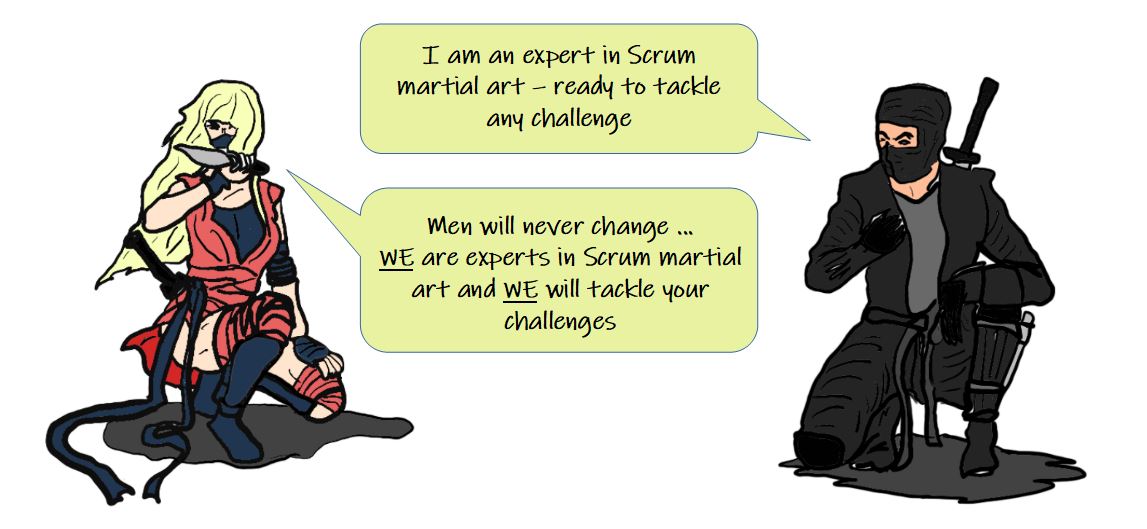
Experienced team members must pay attention in order not to invalidate the willingness of the contribution from less experienced team members.
It's particularly crucial to properly receive and answer opposite opinions that the majority of the group do not agree with.
Openness
The scrum value "openness" is often one of the primary differentiators between an average and high-performer scrum team. It would help if you resembled the openness capability of a scrum team to the vast ability of a collection of openminded individuals.
They're creative, innovative, intellectual, honest, direct, and humble. In the scrum software engineering and delivery process, there is no inappropriate opinion, decision, and action.
The only condition is that they must be transparent, and they should aim to contribute to the joint mission of the scrum team.
It doesn't mean that every decision and action must necessarily accelerate the outputs of the scrum team, and they should result in substantial success stories.
Thanks to openness and courage values, the scrum software development group is not afraid of making mistakes. They see their errors and less than optimal outcomes as vital chances to meaningfully improve their overall productivity and quality of work.
Main Components of Scrum Framework
Scrum framework recognizes three roles: the product owner, the scrum team, and the scrum master.
In addition to other programs it's providing to its worldwide students, International Scrum Institute™ provides three primary training and certification programs for these three roles.
These programs are namely Scrum Product Owner Accredited Certification™ (SPOAC™), Scrum Team Member Accredited Certification™ (STMAC™), and Scrum Master Accredited Certification™ (SMAC™).
A proper scrum organization must adequately possess people from all these three skillsets. That's particularly essential to succeed with the scrum software development framework.
None of these roles is indispensable and irreplaceable. They aren't combinable with the other scrum roles and functions.
Each scrum product owner typically works together with one scrum team. Each scrum team has its own scrum master, and each scrum master cares and works with one single scrum team.
Please don't underestimate the importance of understanding the purpose and function of these roles and employing them with adequate talents. Many times we observed that the root cause of difficulties of a scrum team is either because these roles are not understood or they don't employ the right people.
Let's talk about these three roles now.
Three Scrum Roles - Scrum Product Owner Role
The scrum product owner decides the software requirements delivered for a specific software version, and when the software will be released. She represents functional and non-functional demands from end-users.
The product owner's role is far broader than traditional project management, program manager, or product management roles.
That role unifies product and project management tasks, and it's also firmly integrated with software development and delivery.
Essential tasks of a scrum product owner are:
- To manage and clarify project requirements,
- To guide releases and to ensure return on investment (ROI),
- To closely work with the scrum team,
- To manage stakeholders.
Three Scrum Roles - Scrum Team Member Role
The scrum team implements the software. Scrum team members jointly decide the number of requirements that they can undoubtedly deliver during a particular product increment called "Sprint".
A high-performer scrum team has most of the software engineering skills typically in it. Software developers, architects, testers, database administrators, and team members from all other roles work together.
They jointly build and deliver great software their client is paying for.
Scrum team members do no longer belong to a functional silo of a matrix organization. Developers do no longer belong to software development competence centers, and testers do no longer belong to the software testing competence center, and so on.
Regardless of their past coordinates in the organization, members of a scrum team belong to their particular scrum project. Now their job is to build the best possible software to deliver the requirements of their scrum product owner.
Characteristics of scrum teams are:
- Empowered,
- Autonomous,
- Cross-functional,
- Self-organized,
- Small,
- Full-time participants,
- Working in the same room,
- One for all, all for one.
Three Scrum Roles - Scrum Master Role
The scrum master serves all participants of a scrum project and the external stakeholders to comprehend and apply the scrum framework correctly. She supports the scrum team to execute the scrum process successfully and contributes them to improve their productivity and performance continuously.
The role of the scrum master is to establish the scrum process, the new way of thinking and acting.
Furthermore, the scrum master acts as a change agent. She coaches the team to develop new team norms and standards. She has her desk somewhere very close to the rest of the scrum team.
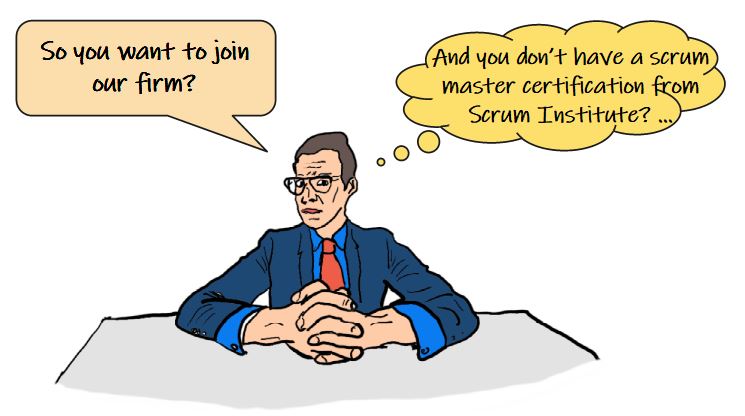
Essential tasks of a scrum master owner are:
- To establish scrum in his business and IT ecosystem,
- To coach the team to understand and live the values of the scrum,
- To ensure close collaboration between the scrum product owner and the scrum team,
- To remove impediments,
- To lead by serving,
- To moderate the scrum rituals (scrum events).
Product Backlog (Scrum Backlog)
Product Backlog (Scrum Backlog) or Scrum Product Backlog is the central element to manage all of the known requirements of a scrum project.
It consists of all customer requirements and work results that are needed to execute and finish a successful project. As requirements, you count functional and non-functional requirements and other features related to user experience and user interface design.
The product backlog contains feature requests and their high-level user stories. These can also include pre-requisite or complementary project requirements such as building test and development environments. Moreover, other user stories required to resolve known bugs or reduce technical debt or improve certain software features have also their places in product backlog as well.
Every scrum project has its product backlog. The scrum product owner is responsible for the creation, maintenance, and fine-tuning of a product backlog. The product backlog doesn't and shouldn't answer the question of how these requirements will be developed and delivered.
That's the duty of the scrum team. The scrum team decides and documents the required tasks to address these requirements in sprint backlogs. Note that product backlog and sprint backlog are physically separate entities although entries in the product backlog drive the contents of the sprint backlog.
The product backlog is a living document. Similar to how the software incrementally improves, the product backlog grows in time as well. Scrum framework doesn't require a separate change management process per se. The scrum product owner creates the first versions of the product backlog based on his best initial understanding of the product.
While she closely observes how the product emerges from sprint to sprint and while her knowledge about client requirements augments, she adds, removes and fine-tines requirements in the product backlog.
The scrum product owner prioritizes requirements in the product backlog. The more priority an element in the product backlog has, the more details it should contain. So the scrum team can easily make sense of these high-priority requirements and create the required tasks to build them.
Furthermore, by using story points, the scrum team regularly estimates the requirements in the product backlog. These estimations should be fine-tuned and improved for high-priority user stories to make them ready for sprint planning.
Sprints
In the scrum framework, all activities to implement the requirements happen during sprints. Sprints are cycles of work activities to develop shippable software product or service increments. Sprints are also sometimes called iterations.
You think about sprints as if they're micro-projects. As the term "Sprint" implies, a sprint doesn't take long, and it's maximum for four weeks.
Different from a running race, at the end of a sprint, the scrum team shouldn't be out of breath and power. Instead, the scrum should be fresh, and they should energetically start the next sprint.
The scrum software development and delivery framework has nothing to do to create pressure and stress for its team members. It's a well-known fact that people perform best when they can work focussed, relieved, and undistracted. If it's applied correctly this what sprints help us accomplish.
Every sprint starts with a Sprint Planning Meeting. During the sprint planning meeting, the scrum team decides what and how many requirements they will implement in this given sprint. Subsequently, the scrum team starts the execution of activities to deliver requirements.
Daily Scrum (Daily Scrum Meeting) happens every day at the same time in the same place. The goal of this meeting is to align all member of the scrum team regularly. Scrum team members can also ask help from the scrum master to remove any impediments which may potentially slow down or block the progress of a sprint.
The scrum team finalizes a sprint with Sprint Review and Sprint Retrospective meetings. The Sprint Review Meeting enables the scrum product owner to review and control the work results the scrum has created during the sprint.
During the Sprint Retrospective Meeting, the scrum team reflects the way they work together, how they use the Scrum framework, and how they can improve.
So the scrum team jointly takes these improvement potentials and feedback into account during the next Sprint Planning Meeting. Sprints enable such feedback loops during short periods with small batch sizes of work. That's one of the significant reasons why and how the Scrum framework helps teams and organizations to improve themselves continuously.
Scrum Inspect and Adapt
Scrum Inspect and Adapt is a straightforward concept to comprehend, but the hardest to properly implement and master.
Companies have finally confirmed that none of their project managers can fully foresee the big picture of complex systems. They were unable to do reliable end-to-end planning. It was evident for them that they needed to try something different.
Together with lean manufacturing (also known as lean movement), companies needed to develop a process to empower them strategically. They needed a standard operating procedure to help them learn and fix their courses of action while they're running their projects and even operations.
That was the birth of Toyota Improvement Kata, which we today call "Inspect and Adapt" while we talk about scrum software development and delivery framework. According to "Scrum Inspect and Adapt":
- Step 1. Inspect: We do our best to grasp the current status of the project with our current level of knowhow and understanding about it.
- Step 2. Adapt: We define a direction and vision about the next steps of our project and then strategize and execute our vision.
- Step 3. Learn: We carefully observe, learn, and teach each other while we do so. We continuously log what works and what doesn't work while we do our work.
- Step 4. Restart: Start over from Step 1 once again.
Note that those four steps described above are analog, but not limited to the following scrum rituals (scrum events).
- Step 1. Inspect is analog to Sprint Review Meetings and Sprint Retrospective Meetings.
- Step 2. Adapt is analog to Sprint Planning Meetings.
- Step 3. Learn is analog to Daily Scrum Meetings.
- Step 4. Restart is analog to the closure of a sprint and the start of a new sprint.
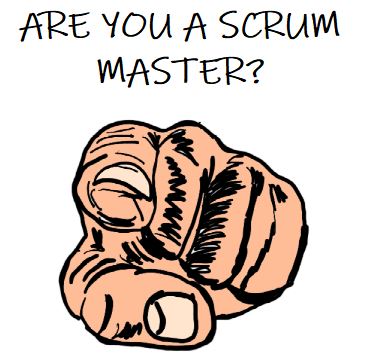
Self-Organization
The scrum team organizes itself. Scrum team members decide in consensus about tasks they need to execute to deliver the goals of a sprint. A self-organized team doesn't require a manager or a team leader.
Self-organization in the scrum framework is very disciplined.
Sprint Backlog, Sprint Burndown Chart, and Daily Scrum Meetings make the foundation of self-organization.
Organizing the work by themselves requires for the most teams a learning phase. Competent scrum masters who own scrum master certifications support their scrum teams to excel with self-organization quickly.
Self-organization also includes the ability to work together despite different opinions and possible conflicts among various scrum team members. Self-organization requires compliance and trust in joint decision-making processes.
Those decision-making process in the scrum framework includes, but not limited to, planning, estimating, implementing, reporting, and reviewing the work the scrum team is jointly responsible.
Five Scrum Rituals (Scrum Events)
Scrum Ritual 1. Sprint Planning Meeting (WHAT-Meeting, HOW-Meeting)
During the Sprint Planning Meeting, the Scrum team builds a viable Sprint Backlog which determines the requirements the team is going to implement until the end of this product increment.
The duties of various Scrum roles during Sprint Planning Meetings are the following:
- The Product Owner introduces the sprint goal and her preselection of requirements which should go into the product increment.
- The Scrum Team identifies the required tasks and their estimations. It's the role of the Scrum Team to decide which and how many requirements preselected by the product owner they can confidently deliver in this sprint.
- The Scrum Master moderates the meeting. She ensures that the self-organization and autonomous decision-making capability of the Scrum Team remain intact.
During Sprint Planning Meetings, the presence of the Scrum Product Owner is mandatory. So she can answer questions from the Scrum Team and bring clarifications for the requirements and their acceptance criteria.
Stakeholders such as end-users or line managers can join Sprint Planning Meetings as view-only audiences. They're not allowed to influence the flow of the Sprint Planning Meeting.
Scrum Ritual 2. Daily Scrum Meeting (Daily Stand-up Meeting)
The Daily Scrum Meeting is a maximum of 15 minutes meeting. These meetings take place every working at the same time in the same place. It's best to conduct Daily Scrum Meetings with direct access to the Sprint Backlog and Sprint Burndown Chart. So the Scrum Team can direct the Daily Scrum Meeting based on the facts and progress which are visible to everyone in the team.
Daily Scrum Meeting aims to support the self-organization of the Scrum Team and identify impediments systematically.
All members of the Scrum Team, the Scrum Master and the Scrum Product Owner need to join Daily Scrums. Other stakeholders can also join these meetings, but only as a view-only audience.
Daily Scrum Meetings are structured in the following way. Every member of the Scrum Team answers three questions.
- Daily Scrum Meeting - Question #1. What activities have I performed since the last Daily Scrum Meeting?
- Daily Scrum Meeting - Question #2. What activities am I planning to perform until the next Daily Scrum Meeting? What is my action plan?
- Daily Scrum Meeting - Question #3. Did I encounter or am I expecting any impediment which may slow down or block the progress of my work?
The Scrum Master has to moderate Daily Scrum Meetings. She needs to ensure disciplined and fast-pacing progress so that all team members can answer these three questions in at most 15 minutes.
The goal of Daily Scrum Meetings does not include to give time-consuming decisions or solve problems. To align on decisions and solve problems, the Scrum team can organize separate on-demand basis meetings. These separate meetings to focus on decisions or issues take usually place subsequently after Daily Scrum Meetings.
The Scrum Master documents the identified impediments and its dates in a separate log, flip chart or report which is accessible to the team. I find it very beneficial to quickly update the status of open impediments at the very end of Daily Scrum Meetings.
Scrum Ritual 3. Sprint Review Meeting
The Sprint Review Meeting happens at the end of the sprint. Regardless of the duration of the sprint, it usually takes one to two hours. Depending on the type of software and available infrastructure, the sprint review meetings take place in a meeting room, in a lab or in the room of the Scrum team.
The goal of the Sprint Review Meeting is to review the shippable product increment built during the sprint and bring transparency to the product development process.
The Scrum team demonstrates its work results. The Product Owner controls whether the Scrum team delivered the requirements they had committed during the Sprint Planned Meeting accurately or not.
The Sprint Review Meeting enables the Product Owner to inspect the current status of the product and adapt the goals of the subsequent sprint. Therefore, Sprint Review Meetings are a formal and practical application of "inspect and adapt".
Participants of the Sprint Review Meeting are the Scrum team, the Scrum Product Owner, the Scrum Master. Optionally all other stakeholders such as end-users, clients, business representatives can join Sprint Review Meetings.
In Sprint Review Meetings, they're allowed to deliver their feedback about the demonstrated product increment. In this way, the Scrum team has the opportunity to get unfiltered and direct input from stakeholders whom they're building software for.
Scrum Ritual 4. Sprint Retrospective Meeting
The Sprint Retrospective Meeting happens directly after the Sprint Review Meeting, and it closes the sprint.
The goal of the Sprint Retrospective Meetings is to improve the teamwork of Scrum team members and the application of the Scrum process.
Therefore, Sprint Retrospective Meetings lead to an increase in productivity, the performance of team members, and the quality of software.
A Sprint Retrospective Meeting is virtually a mini-post-mortem to define improvement potentials and remove process-related obstacles. Some examples of such improvement potentials that we frequently see in our project are:
Without exception, the Scrum team conducts Sprint Retrospective Meetings at the end of every sprint. Only in this way, these meetings enable the Scrum team to systematically adapt and improve their use of the scrum process to the specifics of their project.
Scrum Ritual 5. Product Backlog Refinement Meeting (Grooming Meeting)
Scrum Backlog Refinement (Grooming) Meetings aim to keep the Product Backlog up to date. So the Product Backlog reflects the best know-how and understanding of the Scrum team about the ongoing Scrum project.
Scrum Backlog Refinement meetings can happen on-demand or scheduled basis up to two times a week, 30 minutes each session. The Scrum team, the Scrum Product, and the Scrum Master participate in these meetings.
During Scrum Backlog Refinement (Grooming) meetings, the participants finetune the Product Backlog with the following actions:
- Add new user stories based on newly discovered requirements.
- Remove user stories which are no longer required for the product.
- Fine-tune estimates of user stories.
- Update priorities of user stories.
- Split giant user stories into digestible smaller user stories, and prioritize them accordingly.
Four Easy Steps To Get Your Scrum Master Certification
How to get your scrum master certification is very straightforward, quick, and entirely online.
Thanks to International Scrum Institute™, you now become certified as a scrum master faster and more economically than ever.
Four easy steps to get your scrum master certification without waste of time, without waste of money and without hassle are following.
-
Step #1. Register Online
Register your scrum master certification online by using your Scrum Master Accredited Certification™ Registration Page.
After your registration, International Scrum Institute™ is going to deliver your exam access code instantly online.
From the following link, you can Register Your Scrum Master Certification Program.
-
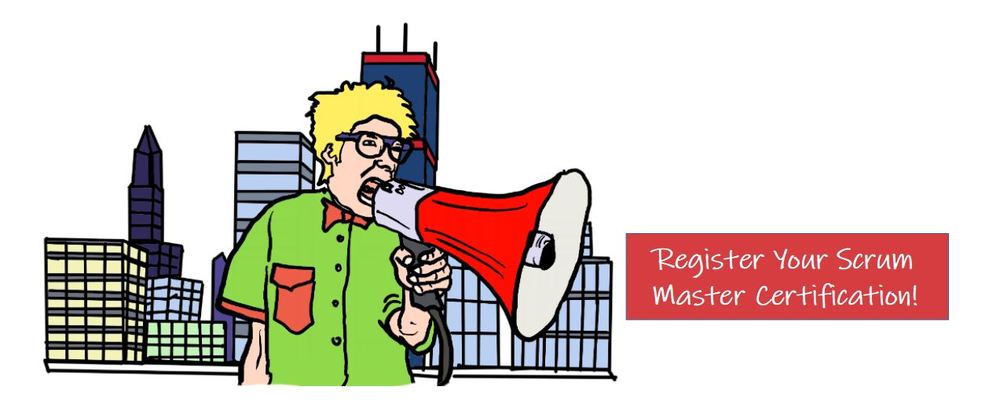
Step #2. Study Online
Study for your scrum master certification online by using your Scrum Study Guide, The Scrum Framework™.
The Scrum Framework™ is designed to become wholly practice-oriented. So its contents will help you deal with your daily challenges in your job and your career as a talented scrum master. The Scrum Framework™ is full of case studies and practical examples to demonstrate the day of the life of the most successful scrum masters.
From the following link, you can Request Your Free of Charge Copy of The Scrum Framework™.
-
Step #3. Make Your Scrum Master Certification Test Online
Once you carefully read, study, and digest your Scrum Study Guide, The Scrum Framework™, you should be now ready! You should be now feeling absolutely confident to pass your scrum master certification exam.
From the following link, you can Access Your Scrum Master Certification Exam.
-
Step #4. Get Your Scrum Master Certification
Once you pass your exam, we will immediately deliver your scrum master certification.
Your employers and clients can validate the authenticity of your certification by using your Scrum Certification Validation Tool for Employers. From the following link, you can Access Your Scrum Certification Validation Tool for Employers.
My Scrum Master Certification Conclusion
It's now the time to recap. If you didn't get a chance to read every word in this step-by-step guide of becoming a scrum master, let me break down my thoughts. Here are my thoughts about the pros and cons of getting certified as a scrum master.
The Pros
Pros for Employees, Freelancers, Coaches and Trainers
- A scrum master certification will be your recognition of competence and up-to-date knowhow in the Scrum domain.
- A scrum master certification will help you outcompete your peer group who do not develop themselves anymore. It will help you get hired for your dream job as a certified and accomplished scrum master.
- A scrum master certification will broaden your perspective, and it will further open up your mind for continuous learning. It will help you get more responsibilities and fantastic career opportunities.
- A scrum master certification will provide a brand new toolset with which you can deliver great products and services that your clients and employers would love.
Pros for Organizations and Employers
- Scrum master certifications will reduce costs by improving the efficiency of your teams, activities, and processes.
- Scrum master certifications will help you win projects with your trained and skilled employees that you couldn't win otherwise.
- Scrum master certifications will improve employee satisfaction and commitment by encouraging them to get trained and develop skills.
- Scrum master certifications will improve the quality of your deliverables, customer satisfaction, and ultimately, the success and profitability of your organization.
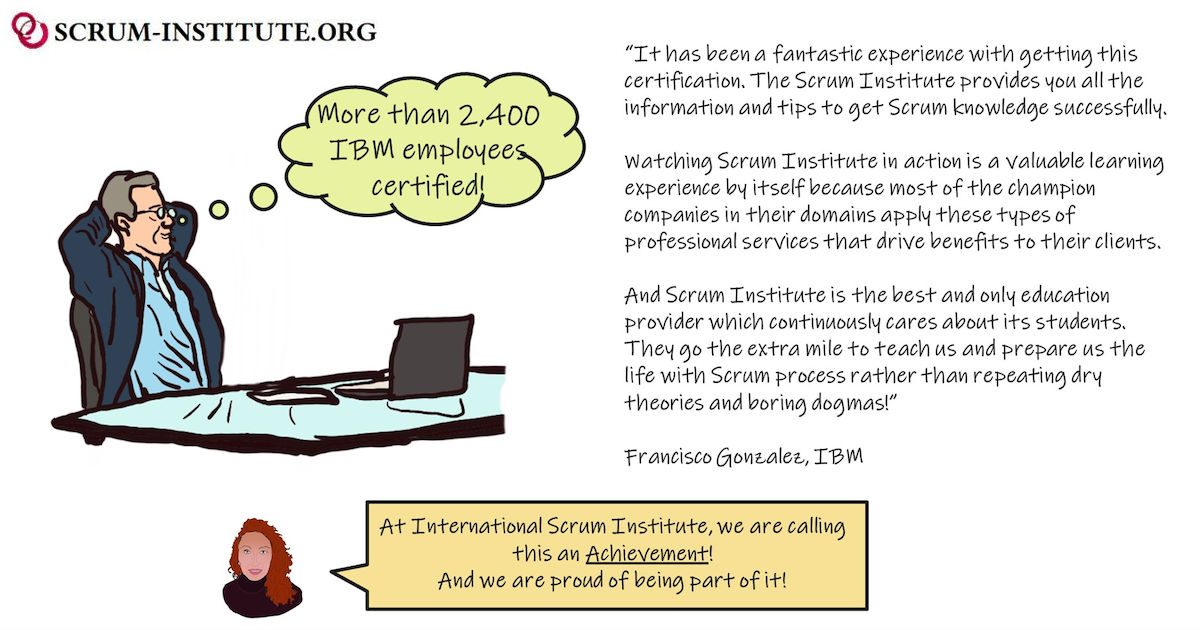
The Cons
-
A scrum master certification shouldn't stop your learning. Don't forget that getting certified as a scrum master is just the first step.
In the spirit of "inspect and adapt" which you learned from the Scrum framework, it's still your duty and obligation to experiment, observe, and learn continuously.
-
There is no one size fits all solution for all organizations around the world. The Scrum software development and delivery framework is no exception to this rule.
What we observed was that: Most organizations that we're unable to get the best performance out of the scrum framework have a common characteristic. These are the organizations that failed to adapt Scrum to their own business and IT-ecosystems.
Therefore, again in the spirit of "inspect and adapt", don't see the scrum framework as a 100% guaranteed recipe for success. Please don't underestimate your cognitive ability to adapt it to the own dynamics of your business and IT. In fact, as a paid professional, this is what you're supposed to do to get the best throughput and business results by using the scrum framework.
-
Scrum didn't solve all the problems we have in our IT departments. Don't stop developing yourself with newly emerging software development and delivery processes such as DevOps.
To better understand the known flaws of the Scrum framework and how DevOps handles them, have a look at this top article at a later moment: What Are TOP 6 Differences Between DevOps and Scrum?
In conclusion, a scrum master certification is an excellent way to get started with agile software development and delivery practices.
According to a Gartner study "Becoming a Better Scrum Master" published in 2019, until 2023, 92% of companies worldwide, and 96% of companies in the United States will be adopting agile scrum practices.
Therefore, there will be no better time other than now for you to
The only remaining question is, when are you going to get started?
Register Scrum Master Certification >>
Scrum Master Certification Made Economical: Step-by-Step Plan
|
|

|

|

|

|
|
 SCRUM INSTITUTE™
SCRUM INSTITUTE™